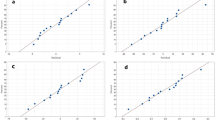Abstract
A series of non-toxic and environmentally benign solvent systems, composed of water/ethanol, acidified with either acetic or citric acid, were tested for their efficiency in extracting polyphenols from dried carob kibbles. The best solvent system (30 % ethanol) was then used in a kinetic study, attempted by deploying non-linear regression. The leaching of polyphenols was found to obey 2nd-order kinetics, while the correlation of the total polyphenol yield at saturation with temperature obeyed a 3-parameter exponential growth model. The highest yield of total polyphenols at saturation was 53.76 mg gallic acid equivalents per gram of dry weight, achieved at 60 °C. The analysis of this extract using liquid chromatography–diode array–mass spectroscopy led to the tentative identification of gallic acid, myricetin 3-O-rhamnoside, quercetin 3-O-rhamnoside and quercetin p-hydroxy benzoyl 3-O-rhamnoside. The detection of the last compound in carob extracts is reported for the first time.






Similar content being viewed by others
Abbreviations
- dw:
-
Dry weight
- GAE:
-
Gallic acid equivalents
- TP:
-
Total polyphenols
- TRE:
-
Trolox equivalents
- AAR :
-
Antiradical activity
- k :
-
Extraction rate constant
- T:
-
Temperature (°C)
- t :
-
Time (h)
- YTP :
-
Extraction yield in total polyphenols (mg GAE g−1 dw)
- YTP(s) :
-
Extraction yield in total polyphenols at saturation (mg GAE g−1 dw)
References
Batlle, I., Tous, J.: Carob tree (Ceratonia siliqua L.). Promoting the conservation and use of under utilized and neglected crops. Institute of Plant Genetics and Crop Plant Research, Gatersleben/International Plant Genetics Resources Institute, Rome (1997)
Morton, J.: Carob, fruits of warm climates. Morton JF, Miami (1987)
Roseiro, L.B., Tavares, C.S., Roseiro, J.C., Rauter, A.P.: Antioxidants from aqueous decoction of carob pods biomass (Ceratonia siliqua L.): optimisation using response surface methodology and phenolic profile by capillary electrophoresis. Ind. Crops Prod. 44, 119–126 (2013)
Zam, W., Bashour, G., Abdelwahed, W., Khayata, W.: Simple and fast method for the extraction of polyphenol and the separation of proanthocyanidins from carob pods. Schol. Acad. J. Pharm. 2, 375–380 (2013)
Kumazawa, S., Taniguchi, M., Suzuki, Y., Shimura, M., Kwon, M.-S., Nakayama, T.: Antioxidant activity of polyphenols in carob pods. J. Agric. Food Chem. 50, 373–377 (2002)
Makris, D.P., Kefalas, P.: Carob pods (Ceratonia siliqua L.) as a source of polyphenolic antioxidants. Food Technol. Biotech. 42, 105–108 (2004)
Aissani, N., Coroneo, V., Fattouch, S., Caboni, P.: Inhibitory effect of carob (Ceratonia siliqua) leaves methanolic extract on Listeria monocytogenes. J. Agric. Food Chem. 60, 9954–9958 (2012)
Owen, R.W., Haubner, R., Hull, W.E., Erben, G., Spiegelhalder, B., Bartsch, H., Haber, B.: Isolation and structure elucidation of the major individual polyphenols in carob fibre. Food Chem. Toxicol. 41, 1727–1738 (2003)
Papagiannopoulos, M., Wollseifen, H.R., Mellenthin, A., Haber, B., Galensa, R.: Identification and quantification of polyphenols in carob fruits (Ceratonia siliqua L.) and derived products by HPLC-UV-ESI/MSn. J. Agric. Food Chem. 52, 3784–3791 (2004)
Turhan, I., Tetik, N., Aksu, M., Karhan, M., Certel, M.: Liquid–solid extraction of soluble solids and total phenolic compounds of carob bean (Ceratonia siliqua L.). J. Food Proc. Eng. 29, 498–507 (2006)
Roseiro, L.B., Duarte, L.C., Oliveira, D.L., Roqueb, R., Bernardo-Gilb, M.G., Martins, A.I., Sepúlveda, C., Almeidac, J., Meireles, M., Gírioa, F.M., Rauter, A.P.: Supercritical, ultrasound and conventional extracts from carob (Ceratonia siliqua L.) biomass: effect on the phenolic profile and anti proliferative activity. Ind. Crops Prod. 47, 132–138 (2013)
Vázquez, G., Freire, M.S., Santos, J., Antorrena, G., González-Álvarez, J.: Optimisation of polyphenols extraction from chestnut shell by response surface methodology. Waste Biomass Valor. 1, 219–225 (2010)
Demiray, S., Piccirillo, C., Rodrigues, C.L., Pintado, M.E., Castro, P.M.L.: Extraction of valuable compounds from Ginja cherry by-products: effect of the solvent and antioxidant properties. Waste Biomass Valor. 2, 365–371 (2011)
Arnous, A., Makris, D.P., Kefalas, P.: Correlation of pigment and flavonol content with antioxidant properties in selected aged regional wines from Greece. J. Food Compos. Anal. 15, 655–665 (2002)
Makris, D.P., Boskou, G., Andrikopoulos, N.K.: Recovery of antioxidant phenolics from white vinification solid by-products employing water/ethanol mixtures. Biores. Technol. 98, 2963–2967 (2007)
Ho, Y.-S., Harouna-Oumarou, H., Fauduet, H., Porte, C.: Kinetics and model building of leaching of water-soluble compounds of Tilia sapwood. Sep. Purif. Technol. 45, 169–173 (2005)
Pan, Ζ., Qu, W., Ma, H., Atungulu, G.G., McHugh, T.H.: Continuous and pulsed ultrasound-assisted extractions of antioxidants from pomegranate peel. Ultrason. Sonochem. 19, 365–372 (2012)
Rakotondramasy-Rabesiaka, L., Havet, J.-L., Porte, C., Fauduet, H.: Solid–liquid extraction of protopine from Fumaria officinalis L.—analysis determination, kinetic reaction and model building. Sep. Purif. Technol. 54, 253–261 (2007)
Ayaz, F.H., Torun, H., Ayaz, S., Correia, P.J., Alaiz, M., Sanz, C., Grúz, J., Strnad, M.: Determination of chemical composition of anatolian carob pod (Ceratonia siliqua L.): sugars, amino and organic acids, minerals and phenolic compounds. J. Food Qual. 30, 1040–1055 (2007)
Şahin, H., Topuz, A., Pischetsrieder, M., Özdemir, F.: Effect of roasting process on phenolic, antioxidant and browning properties of carob powder. Eur. Food Res. Technol. 230, 155–161 (2009)
Joslyn, M.A., Nishira, H., Ito, S.: Leucoanthocyanins and related phenolic compounds of carob pods (Ceratonia siliqua). J. Sci. Food Agric. 19, 543–550 (1968)
Author information
Authors and Affiliations
Corresponding author
Rights and permissions
About this article
Cite this article
Cavdarova, M., Makris, D.P. Extraction Kinetics of Phenolics from Carob (Ceratonia siliqua L.) Kibbles Using Environmentally Benign Solvents. Waste Biomass Valor 5, 773–779 (2014). https://doi.org/10.1007/s12649-014-9298-3
Received:
Accepted:
Published:
Issue Date:
DOI: https://doi.org/10.1007/s12649-014-9298-3




